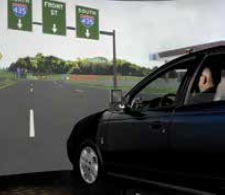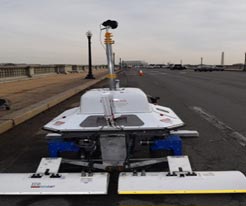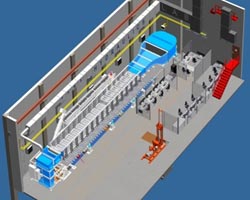U.S. Department of Transportation
Federal Highway Administration
1200 New Jersey Avenue, SE
Washington, DC 20590
202-366-4000
Federal Highway Administration Research and Technology
Coordinating, Developing, and Delivering Highway Transportation Innovations
|
R&T NOW This newsletter is an archived publication and may contain dated technical, contact, and link information. |
|
| Publication Number: N/A Date: March/April 2015 |
Publication Date: March/April 2015
|
PDF files can be viewed with the Acrobat® Reader®
FHWA Discusses RT&E Budget with House Subcommittee Staff
FHWA recently discussed its 2016 Research, Technology, and Education (RT&E) budget with minority staff from the U.S. House of Representatives Committee on Science, Space & Technology Subcommittee on Research & Technology (including Staff Director Dahlia Sokolov and Professional Staff Member Brystol English). Of particular interest to the staff was FHWA’s Exploratory Advanced Research (EAR) program and the Technology and Innovation Deployment program activities of Every Day Counts (EDC), the State Transportation Innovation Councils, and other research and technology activities. Some of the conversation from Subcommittee staff sprung from a visit they had to Turner-Fairbank Highway Research Center (TFHRC) last summer.
For more information, contact Jack Jernigan, 202-493-3363, jack.jernigan@dot.gov, or Lucia Olivera, 202-493-3320, lucia.olivera@dot.gov.
Summary Report: National Multimodal Freight Analysis Framework Research Workshop
This report summarizes the workshop, “National Multimodal Freight Analysis Framework Research,” held on December 11, 2013 at the National Academies of Sciences’ Keck Center in Washington, D.C. The workshop outlined a vision for the next generation of freight analysis, recognized primary gaps in current capabilities, and created a game plan to address these gaps.
The summary report is available at www.fhwa.dot.gov/advancedresearch/pubs/14054/index.cfm.
For more information about the Freight Analysis Framework, contact Ed Strocko, 202-366-2997, ed.strocko@dot.gov. For more information about the EAR Program, contact David Kuehn, 202-493-3414, david.kuehn@dot.gov.
Catalog: EAR Program Research Results—Updated through 2014
This catalog covers the EAR Program’s research results for 2014. The catalog documents a critical link in the chain of research, development, and deployment of new technology and practices necessary for the United States to have the best transportation system in the world for decades to come. The results of EAR Program-funded projects may include new fundamental insights and how they can be applied in highway transportation; new research methods, models, or data that can accelerate applied research; or new system concepts or prototypes, including laboratory testing and possibly limited field testing. FHWA is committed to transitioning the results of EAR Program-funded projects and takes an active role in demonstrating results to audiences critical to continuing the research and development cycle.

TFHRC's Highway Driving Simulator
The catalog is available at www.fhwa.dot.gov/advancedresearch/pubs/15024/index.cfm.
For more information about the EAR Program, contact David Kuehn, 202-493-3414, david.kuehn@dot.gov.
RABIT Inspects Arlington Memorial Bridge
On March 9, 2015, FHWA deployed its RABIT Bridge Deck Assessment Tool to assess and document the condition of all six lanes of the National Park Service’s (NPS) Arlington Memorial Bridge. FHWA, in collaboration with Rutgers University, developed the RABIT bridge deck assessment tool to rapidly detect and document in near real-time three of the most common deterioration types in concrete bridge decks: rebar corrosion, delamination, and concrete degradation. The tool can collect high-quality research data on the condition of concrete bridge decks.
The information collected by RABIT may help bridge owners like NPS make data-driven decisions to maintain, preserve, and manage their bridge infrastructure assets more effectively. Upon completion of the Arlington Memorial Bridge deck study, RABIT will be deployed to assess NPS’s Windy Run Bridge, which is expected to take 2 days to complete.

RABIT Bridge Deck Assessment Tool
For more information, contact Hamid Ghasemi, 202-493-3042, hamid.ghasemi@dot.gov.
AASHTO Subcommittee Develops Vision for Concrete Bridges
The American Association of State Highway and Transportation Officials (AASHTO) Subcommittee on Bridges and Structures Technical Committee #10 (SCOBS T-10) recently conducted an exercise aimed at reflecting on past accomplishments and refining a collective vision for the future. The committee and select partners arrived at a 25-year vision that would encourage such advancements as performance-based specifications, maintenance-free bridges, and risk-based design. Participants from FHWA included Ben Graybeal, who heads the Structural Concrete Research Program, and Reggie Holt from the Office of Bridges and Structures.
The development of a vision comes at a time when there is a growing recognition that the highway and bridge sectors are so stretched that thought leaders rarely have an opportunity to think beyond tactical, day-to-day considerations. Graybeal’s white paper, “A Vision for Structural Concrete Research,” published in ASPIRE magazine last summer, helped jump-start this effort—prompting the T-10 chairman to create a task group, call for this meeting, and instruct the group to continue through further strategic planning efforts.
For more information, contact Ben Graybeal, 202-493-3122, benjamin.graybeal@dot.gov.
Turner-Fairbank Welcomes New Flume System
A new multifunctional flume system is being installed at FHWA’s J. Sterling Jones Hydraulics Research Laboratory located at TFHRC. Boasting a 90-foot-long and 13-foot-wide tiltable working platform for setting up experiments, the flume system is expected to advance the lab’s ability to predict flooding and scour-related damages and improve design guidance for mitigating impacts on bridges and other hydraulic structures. The flume system (which will replace a 30-year old tilting flume) also features a 27-foot-long flow inlet headworks, an outlet section, and a sediment recirculating capability that is nationally unique. The recirculating capability allows for a much more realistic river flow modeling.

Future Layout of Hydraulics Lab
The flume system will support the hydraulics research program’s strategic vision. Future experimental work will require a large degree of flexibility for setting up and dismantling experiments, as well as highly detailed and automated flow and sediment transport measurements to calibrate numerical models.
For more information, contact Kornel Kerenyi, 202-493-3142, kornel.kerenyi@dot.gov.
Researchers to Evaluate Electroslag Welds
Justin Ocel, a member of FHWA’s Bridge and Foundation Engineering Team, recently observed a fabricator in Bristol, VA make a full-scale electroslag weld test specimen using HPS70W bridge steel. The resulting electroslag welds will be mechanically evaluated at TFHRC. Through its research and development activities in the 1980s and 1990s, FHWA invested significantly in redeveloping the electroslag welding (ESW) process, which is now approved for use in AASHTO’s and the American Welding Society’s D1.5 Bridge Welding Code. There are limitations imposed within D1.5 when using ESW because it was outside the bounds of FHWA’s research and development. For example, HPS steels did not exist when the electroslag research was underway and therefore HPS70W steel cannot be electroslag welded together. Ocel’s site visit was part of a research project aimed at testing the efficacy of ESW with HPS70W steel. Evaluation of the completed welds is expected to determine whether the restriction should be removed from D1.5 or whether further process development must be pursued for ESW use with a broader range of bridge steels.
For more information, contact Justin Ocel, 202-493-3080, justin.ocel@dot.gov.
Researchers Instruct GMU Students at Turner-Fairbank
For the eleventh consecutive year, FHWA’s Office of Infrastructure Research and Development is teaching “Introduction to Experimental Design Engineering” to civil engineering students from George Mason University (GMU). During the 15-week semester, GMU students will receive lectures from representatives of TFHRC’s Structures, Hydraulics, Asphalt Pavements, Concrete Pavements and Geotechnical Laboratories and perform experiments in each of these labs. The class provides GMU students with a survey of common testing and laboratory experimental methods that civil engineers might encounter in their professional practice. The senior-level elective is one of a number of collaborative activities detailed in a Memorandum of Understanding signed in 2004 between GMU and FHWA.
For more information, contact Jorge Pagan-Ortiz, 202-493-3022, jorge.pagan@dot.gov.
FHWA Releases Version 10.1.0 of Interactive Highway Safety Design Model
FHWA recently released version 10.1.0 of the Interactive Highway Safety Design Model (IHSDM), a suite of software analysis tools for evaluating safety and operational effects of geometric design decisions.
The new version includes the following enhancements:
IHSDM supports the Data-Driven Safety Analysis initiative as part of FHWA’s EDC 3 efforts. The IHSDM Crash Prediction Module serves as a faithful implementation of Highway Safety Manual Predictive Methods (Part C) for two-lane rural highways, multilane rural highways, urban and suburban arterials, freeways, and ramps/interchanges.
The software is available for free download at www.ihsdm.org.
For more information, visit www.fhwa.dot.gov/research/tfhrc/projects/safety/comprehensive/ihsdm/index.cfm, or contact Clayton Chen, 202-493-3054, clayton.chen@dot.gov.
Report: Evaluation of Dynamic Speed Feedback Signs on Curves: A National Demonstration Project
Lane departure crashes are a significant safety concern. The majority of lane departure crashes occur on rural two-lane roadways, with a disproportionate number of these crashes on horizontal curves. A primary driver factor in curve-related crashes is speeding. Dynamic speed feedback sign (DSFS) systems are one method to reduce vehicle speeds and, consequently, crashes on curves. These systems show promise but they have not been fully evaluated on curves.
This report presents the results of a national demonstration project conducted by the Center for Transportation Research and Education at Iowa State University to evaluate the effectiveness of two different DSFSs in reducing speed and crashes on curves at 22 total sites on rural two-lane roadways in seven States. Data were collected before and at 1, 12, and 24 months after installation of the DSFS. On average, most sites had decreases in mean speeds, with decreases up to 10.9 miles per hour noted for both the point of curvature (PC) and center of curve (CC). As well, large reductions in the number of vehicles traveling over the posted or advisory speed occurred for all of the after periods at the PC and CC, indicating that the signs were effective in reducing high-end speeds, as well as average and 85th percentile speeds.
This document is available at https://www.fhwa.dot.gov/publications/research/safety/14020/14020.pdf.
For more information, contact Abdul Zineddin, 202-493-3288, abdul.zineddin@dot.gov.
FHWA Discusses V2I Applications and Enabling Technologies at TRB
In January, Benjamin McKeever of FHWA’s Office of Operations Research and Development discussed vehicle to infrastructure (V2I) applications and enabling technologies at the Transportation Research Board’s (TRB) Annual Meeting in Washington, DC. Some of the key points included recognition that the auto industry is moving forward with vehicle to vehicle (V2V) communications and that the National Highway Traffic Safety Administration’s proposed rulemaking may require V2V communications in all vehicles. Integrated V2I prototype and V2I applications testing are nearing completion and connected vehicle pilots are planned from 2015 to 2017. Some of the ongoing support activities include AASHTO’s Footprint Analysis and Connected Vehicle Pooled Fund Study.
For more information, contact Benjamin McKeever, 202-493-3270, ben.mckeever@umd.edu.
NAS Publishes FHWA Research on Micro-Simulation
The National Academies of Science recently published a paper based on research conducted at TFHRC. Published in The Postdoc, a newsletter of the National Academies of Science, the paper focused on traffic performance analysis and dynamic merge control using micro-simulation. Dynamic merge control can be used in freeway merge areas to dynamically change lane allocation at interchanges. The technology can prioritize the roadway having higher volume and close a lane on the lesser-volume roadway. According to the research, after implementing the technology the average delay per vehicle was reduced up to 540 seconds (about 98 percent). Dynamic merge control can also increase average speed by 26 miles per hour (more than 80 percent).
Written by Ximiao Jiang, a postdoctoral scholar working at TFHRC, and Joe Bared, leader of FHWA’s Transportation Operations Concepts and Analysis team, the article is available at: http://sites.nationalacademies.org/cs/groups/pgasite/documents/webpage/pga_153210.pdf.
Yousuf Represents FHWA on FCC’s Disability Advisory Committee
Mohammed Yousuf of FHWA’s Office of Operations Research and Development was recently appointed to serve on the Federal Communications Commission’s Disability Advisory Committee. Representing FHWA, Yousuf will serve a 2-year term as an ex officio member and attend plenary committee meetings. According to the appointment letter, Yousuf will work on various subcommittees and will be asked to represent FHWA’s viewpoints on disability issues and develop recommendations.
For more information, contact Mohammed Yousuf, 202-493-3199, mohammed.yousuf@dot.gov.
Webinars Inform Stakeholders of Research Efforts
FHWA’s Office of Operations Research and Development recently led three Webinars that were part of the Dynamic Mobility Applications Program Webinar Series. Aimed at informing stakeholders and interested parties of research efforts, progress, and impacts, the Webinars covered the Research Data Exchange and Open Source Application Development Portal; the Multimodal Intelligent Traffic Signal System bundle; and the Intelligent Network Flow Optimization bundle. About 500 stakeholders attended these Webinars, which featured an overview of the bundle, a description of prototypes or algorithms, testing and impacts assessment results, and a stakeholder question and answer session.
For more information, contact Joe Peters, 202-493-3269, joe.peters@dot.gov.
ATTRI Webinar Focuses on Travel Needs
A Webinar focused on understanding the travel needs of people with disabilities was recently held to advance the Accessible Transportation Technologies Research Initiative (ATTRI). The target audience was people with disabilities; caregivers; advocates; transportation system managers; State, local, and Federal officials; academics; and individuals involved with technology and mobility needs for people with disabilities. The interactive Webinar walked participants through several scenarios to gather responses and feedback. Participants were asked to express their concerns and problems encountered in fulfilling their travel and transportation needs. They were also asked how they use technology now and how they think technology might help them get to the places they need to go in the future. Directed by FHWA and the Federal Transit Administration, ATTRI aims to enable independent mobility of travelers with disabilities through the use of intelligent transportation systems and other innovative technologies.
For more information, contact Charlene Wilder: 202-366-1077 (phone), 202-366-3765 (fax), charlene.wilder@dot.gov.
Public Roads—January/February 2015
This issue includes: FHWA’s “Innovations Factory” Commands Presidential Attention; Excitement Reigns During Presidential Visit; Innovations Hit the Road; How the Uncommon Became the Commonplace; Slowing Climate Change One Highway at a Time; and The Secret to Making Federal Tax Dollars Work for Your State.
It is available online via www.fhwa.dot.gov/publications/publicroads/15janfeb/index.cfm.
For more information, contact TaMara McCrae, tamara.mccrae@dot.gov.
Innovator: Accelerating Innovation for the American Driving Experience—January/February 2015
This issue includes: Summits Launch Next Round of Highway Innovation; States Innovate!; FHWA Offers Innovation Incentives; Utah DOT Saves Time and Money with GRS-IBS; ABC Slashes Schedule on Virginia Project; STICs Spread Innovation Culture Nationwide; and Calendar.
The issue is available online via https://www.fhwa.dot.gov/hfl/innovator/e-version/issue_46/.
Turner-Fairbank Highway Research Center: www.fhwa.dot.gov/research/tfhrc/
Resource Center: www.fhwa.dot.gov/resourcecenter/
National Highway Institute: www.nhi.fhwa.dot.gov/home.aspx
Please forward this newsletter to others you think might find it interesting and/or useful.
Suggestions may be submitted to: FHWA_Now@fhwa.dot.gov